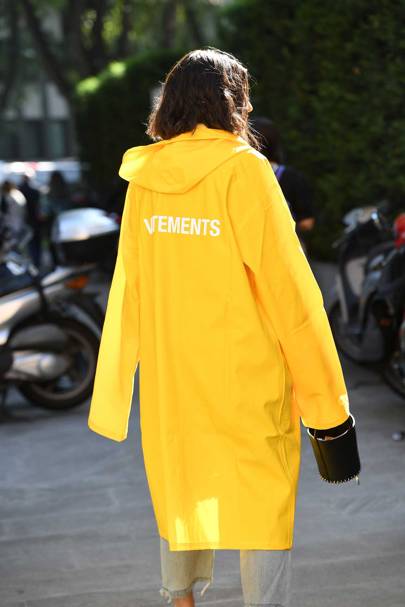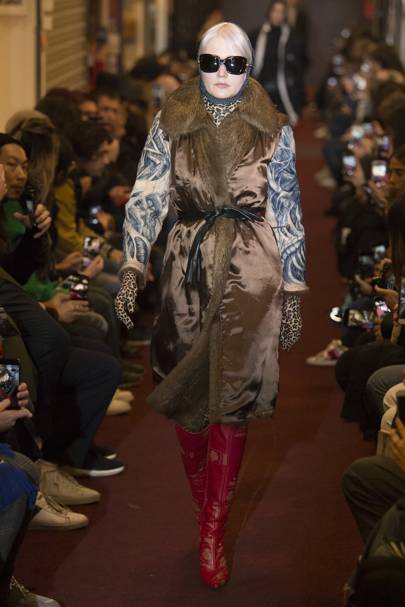“It seems rather strange to talk about the financial results of a privately run company,” he sighed when I asked him the big question of revenue, something he and Demna have never disclosed. “But as it seems there’s been a certain obsession with our financial state, we could give you a little peek behind the curtain,” he smirked. “We have been profitable from season one and our total annual turnover has been increasing ever since. We had a fifty percent growth in the current financial year and a ten thousand percent growth in the past three years. Currently we are making eight digits each season.”
Add to that their relocation to Switzerland last year – a move Guram put down to “getting away from a toxic fashion industry” – and the picture painted isn’t exactly that of declining business. “The only reason to talk about valuation of a non-public company is if you were planning to sell it,” he noted. “We are very happy where we are now; however to satisfy your curiosity, the value of the company is not in the M but rather in the B-region.”
Having just returned from the major fashion weeks and a stint in Seoul, I couldn’t quite match the notion of dwindling sales with the parade of Vetements logos I saw everywhere around the fashion landscape, either. As it turned out, neither could the buyers I posed the question to today. “Generally, Vetements has always been a top-selling brand since we started working with them,” Kei Lee of BoonTheShop in Seoul told me. The famed South Korean boutique first bought the brand for autumn/winter 2015 and experienced a ninety percent sell-through. A few seasons on the budget put into Vetements is four times bigger.
“The sales volume is bigger than Céline, Saint Laurent, Loewe et cetera,” Lee said, noting that they’ve already crossed the 40 percent sell-through mark for spring/summer 2018 making Vetements this season’s “number one selling brand” for the store. “We have waiting lists not just for the current season but for autumn/winter 2018. No doubt it’ll do very well next season as well.”

In the neighbouring Japan, the message is the same: “Even though our budget increased more than double from last spring/summer, as of March 31 sell-through of spring/summer 2018 is already 62 percent in comparison to 64 percent for spring/summer 2017,” Sakiko Hasegawa said of the brand’s sales in Tokyo’s Adelaide. “Our sell-through before sales has never gone under 90 percent.” Last November, I attended one of Vetements’ typically packed customer events at Joyce in Hong Kong where fans from around Asia queued overnight to get their hands on limited edition merchandise. More than a thousand people attended, frantically filling their bags anything that bore the brand’s logo, from hoodies to fridge magnets and even Swiss cowbells, a nod to their new home in Zurich. “Vetements is still one of the strong-performing brands in our portfolio,” Joyce’s merchandising manager Michael Mok told me. “Its sell-through is above our departmental average in both men’s and women’s. Our sales recorded double-digit growth versus last year.”
Joyce has carried Vetements since its very first season and seen significant growth ever since. “We grew the brand in an organic way and the sales have increased organically every season,” Mok said. “To be fair, every brand has their good or bad season but I think Vetements and Demna are still influencing the current fashion market.”
Over in Russia, SVMoscow Tatiana Strekalovskaya told me that selling Vetements has to be matched with the Gvasalia brothers’ own untraditional approach to design and marketing. “The brand is really strong and did a lot to sell itself well. However, stores should put a lot of effort into selling it well. For example, having a good client base. If you put a high budget into Vetements and expect it to bring you millions in a second without doing any activity, it's better just not to buy it.” Since the Moscow store bought the brand in its first season it has never dipped out of their top-five bestseller chart.
“Though we are slightly raising the budget, Vetements doesn't go down. For our store the average performance for the brand is 60 percent sell-through before the 30 percent markdowns start. Vetements always jumps over this mark and shows better performance,” Strekalovskaya added. “Nothing more needs to be said, I think.” In the fashion industry, Vetements have always been operating on unchartered territory. The first in a wave of social media savvy streetwear brands that would include Yeezy, Off-White and Fear of God, they represent an irreverent new generation of contemporary fashion with ideas above its station. The Gvasalias were hailed and hyped to previously unparalleled heights when they broke that glass ceiling. And so, as pioneers on this millennial frontier of the industry, they are also the first to experience the expectation level that comes with such success: an insatiable desire for more and newer ideas every season, at least as far as industry critics are concerned.
But while Vetements so resolutely placed their extortionately priced sports and streetwear on a heritage luxury market built on £4,000 suits and dresses, they never said they were going to stick to that market’s rules of seasonal renewal, endless pre and capsule collections, and whatever else defines the old-fashioned spinning wheel of fashion. In fact, Demna has only ever reiterated the statement he echoed in Friday’s Instagram post: “Fashion is not about hype, nor about useless gossip or opportunistic pseudo journalism. Fashion is about clothes. So is Vetements.” The brand never played by the rules of the establishment, so why would they start to once they were considered a part of it? Designers like Rick Owens and Ann Demeulemeester – and more recently, Gucci’s Alessandro Michele and Saint Laurent’s Anthony Vaccarello – have proved you can build good sales on sticking to your core concept rather than forcing a seasonal and inevitably self-disserving strive for innovation. (The brands best known for that approach, by the way, aren’t doing terribly well these days.)

Considering the revolutionary impact Vetements has had on the fashion industry, you might argue Demna and Guram have already done their part for innovation for the foreseeable decade. “Vetements is a brand that changed the way people dress this century,” Natalie Kingham, the fashion and buying director of MatchesFashion.com, told me. “We believe in good design with authenticity and a point of view. As do our customers. Regardless of trends and hype, Demna and Guram are creatives that will continue to drive forward fashion. Our customer responds really well to the buy.”
When I approached North America, the same pattern continued. “We are very happy with the performance of Vetements at Dover Street Market New York,” the store’s buyer Jamie Gilchrest said. “Vetements continues to be one of our most important partners and remains among our top ten selling brands on a daily basis," said Brigitte Chartrand, womenswear buying director at Ssense in Montreal.
Riccardo G Dallai Jr, owner of Boston’s Riccardi, reflected that Vetements’ vision “of disrupting fashion and becoming an industry leader” was always going to take time. “While in the early seasons sell-throughs were close to 100 percent and not what they are now, Vetements has remained one of the top-performing brands at Riccardi since 2016,” he told me. “In addition to the timing of the brand's rise during the boom of social media, pop-ups, and broadening consumer knowledge, these impressive numbers and their unparalleled consistency are a direct result of the brand setting a precedent and giving its retailers a longer ‘full price’ selling period than any of its peers.” If all is well under the sun, you wonder what spawns the kind of rumours Vetements was subjected to last week. Is it simply an industry overload caused by too much fame and too much success too quickly, or does fashion – not unlike Hollywood – now expect that “what comes up must come down,” as the High Snobriety story suggested?
I asked Guram Gvasalia if he ever senses an industry willingness for Vetements to fail. “I don’t want to think that someone might not wish us well as we never stepped on anyone’s toes or crossed anyone’s way,” he said. “We have always worked extremely hard to get where we are, and if someone doesn’t share our understanding and aesthetic we don’t need to force them to do so. The brand started in a very niche luxury segment but managed to develop a loyal following that goes beyond the initial demographics. It’s important that the person, who wears our clothes doesn’t buy them because of blind following but because he or she truly understands it.”
What of those infamous price points, then? “We know that for many our prices are expensive. We are working on expanding the collection to make sure there are also more affordable items in it,” Gvasalia said and paused. “Today we live a world of extreme political, financial and ecological problems. At the end of the day what happens in fashion is not the end of the world. We all should relax a bit and try to concentrate on joy and good things in life. Namaste!”
When I approached North America, the same pattern continued. “We are very happy with the performance of Vetements at Dover Street Market New York,” the store’s buyer Jamie Gilchrest said. “Vetements continues to be one of our most important partners and remains among our top ten selling brands on a daily basis," said Brigitte Chartrand, womenswear buying director at Ssense in Montreal.
Riccardo G Dallai Jr, owner of Boston’s Riccardi, reflected that Vetements’ vision “of disrupting fashion and becoming an industry leader” was always going to take time. “While in the early seasons sell-throughs were close to 100 percent and not what they are now, Vetements has remained one of the top-performing brands at Riccardi since 2016,” he told me. “In addition to the timing of the brand's rise during the boom of social media, pop-ups, and broadening consumer knowledge, these impressive numbers and their unparalleled consistency are a direct result of the brand setting a precedent and giving its retailers a longer ‘full price’ selling period than any of its peers.” If all is well under the sun, you wonder what spawns the kind of rumours Vetements was subjected to last week. Is it simply an industry overload caused by too much fame and too much success too quickly, or does fashion – not unlike Hollywood – now expect that “what comes up must come down,” as the High Snobriety story suggested?
I asked Guram Gvasalia if he ever senses an industry willingness for Vetements to fail. “I don’t want to think that someone might not wish us well as we never stepped on anyone’s toes or crossed anyone’s way,” he said. “We have always worked extremely hard to get where we are, and if someone doesn’t share our understanding and aesthetic we don’t need to force them to do so. The brand started in a very niche luxury segment but managed to develop a loyal following that goes beyond the initial demographics. It’s important that the person, who wears our clothes doesn’t buy them because of blind following but because he or she truly understands it.”
What of those infamous price points, then? “We know that for many our prices are expensive. We are working on expanding the collection to make sure there are also more affordable items in it,” Gvasalia said and paused. “Today we live a world of extreme political, financial and ecological problems. At the end of the day what happens in fashion is not the end of the world. We all should relax a bit and try to concentrate on joy and good things in life. Namaste!”

No comments:
Post a Comment